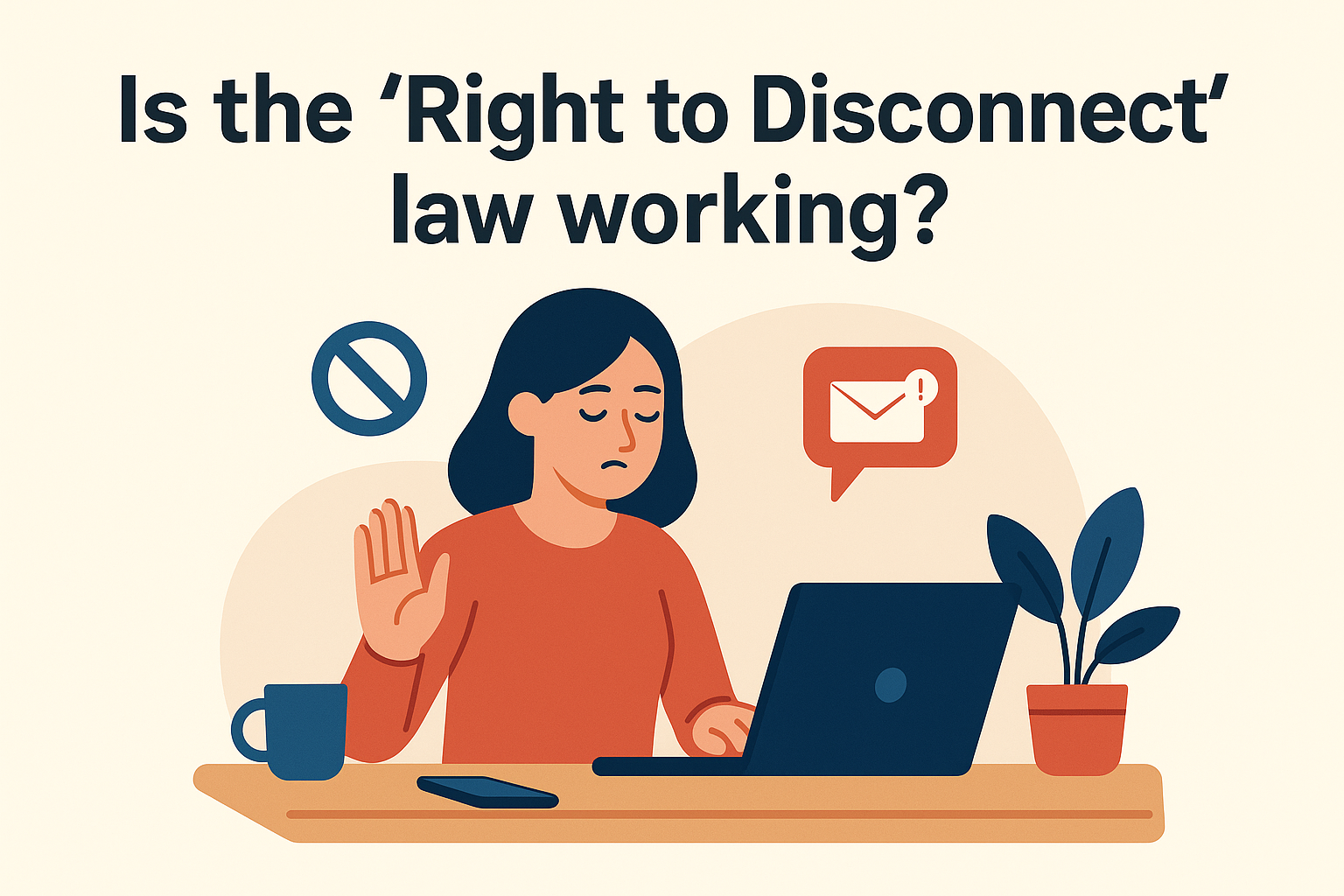The Right to Disconnect
The right to disconnect came into effect for non-small businesses on 26 August 2024, and will apply to small businesses (those with 15 employees or fewer) from 26 August 2025. This right was introduced through amendments to the Fair Work Act 2009 (Cth) (the Act). This followed the Senate’s approval of the Fair Work Legislation Amendment (Closing Loopholes No. 2) Bill 2023 on 8 February 2024.
In essence, the right protects employees from unreasonable work-related contact outside of scheduled work hours. Employees are entitled to refuse such contact unless the refusal is itself unreasonable. This right is set out in section 333M of the Act and protected as a workplace right under Part 3 – 1 of the Act.
The objective of the right is to support employees’ work-life balance and to help define boundaries between work and personal life. It is also intended to address the ‘always-on’ work culture and reduce burnout. By doing so, it aims to improve employee wellbeing and provide clear expectations around contact outside normal work hours.
How has it affected employers?
For many employers, the key change has been in the nature of their ongoing engagement with staff. According to the Fair Work Commission, most concerns are being resolved internally. This suggests that employers are adjusting their practices in line with the law’s intent.
That said, a separate survey found that at least 65% of responding employees still experienced out-of-hours contact. While not necessarily representative of all workplaces, it highlights the importance of employers understanding and implementing the new rules to avoid future disputes. However, it remains to be seen whether widespread structural change will occur. There are early signs that employers are trying to adapt, even where the changes present additional challenges.
With the laws soon to apply to small businesses, there may be greater impacts ahead. Smaller organisations without dedicated HR support may take longer to adjust. This could lead to different trends emerging over the next 12 months. It will be important for small businesses to prepare in advance. Understanding their obligations and seeking advice where needed will be critical to ensure compliance by 26 August 2025.
How has it affected employees?
Research by The Australia Institute’s Centre of Future Work found that unpaid overtime dropped from 5.4 hours to 3.6 hours per week following the introduction of the right. The reduction was particularly significant for workers aged 18–25. A related survey reported that more than half of employers observed improvements in employee engagement and productivity since the changes.
However, many employees still report after-hours contact from their employers. While this does not breach the law, employees should remember that the right allows them to decline the contact in some circumstances, not necessarily to prevent it entirely. This distinction may be a source of confusion and potential conflict, especially where workplace practices are not clearly defined. It is important for both employees and employers to communicate expectations and seek clarification where needed.
Flexible work and remote arrangements also raise new questions about how the right to disconnect applies. Employees should discuss these arrangements with their employers to understand when they are expected to be available and ensure both parties are aligned. If concerns cannot be resolved internally, advice should be sought.
Case Law – Is the right working?
The Fair Work Ombudsman has received around 225 inquiries relating to the right to disconnect in the past six months. Yet, only one formal dispute has been raised. According to Murray Furlong, the General Manager of the Fair Work Commission, this suggests the law is encouraging constructive dialogue between employers and employees.
Notwithstanding this, case law is beginning to emerge. One case involved an employee who was dismissed by email while on sick leave. In Michelle Sciberras v Labour Solutions Australia Pty Ltd [2024] FWC 1615, the Commission found that the dismissal could not be enforced during that period. This was because the employee was not expected to check work emails while unwell. Although not a direct application of the right, the decision reflects similar principles about reasonable contact outside working hours. The full decision can be found here.
A current case before the Federal Court of Australia, Michelle Andrea Martin v Cairns Rudolf Steiner School Ltd, highlights a more direct application of the right to disconnect. Ms Martin, a former teacher, is seeking $780,000 in compensation, claiming she was unfairly dismissed after failing to respond to misconduct allegations during school holidays. She argues that her right to disconnect meant she was not required to reply during that period.
Courts’ decisions in cases like this will play a key role in defining how the right is interpreted and enforced. So far, most cases referencing the new legislation have involved dismissal claims. This trend suggests that employees may increasingly use the right to challenge terminations or seek higher compensation in unfair dismissal proceedings. The outcome will hinge on how courts assess the reasonableness of after-hours contact in specific contexts.
Need assistance?
To discuss how the right may affect your organisation, or for tailored advice on workplace compliance, please contact our team.
Call us at (02) 9181 5001 or email us at [email protected].
Explore our full expertise here: https://integroe.com.au/legal-services/

